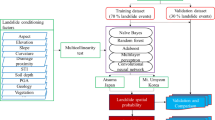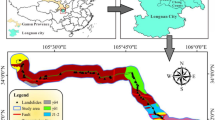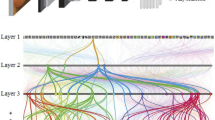Abstract
A hybrid framework by integrating stacking ensemble with two deep learning methods of convolutional neural network (CNN) and recurrent neural network (RNN) is introduced in this paper for landslide spatial prediction in the Three Gorges Reservoir area, China. The proposed framework is summarized in following steps. First, a spatial database consists of 20 landslide conditioning factors and 196 landslide polygons was established. Then, landslide and non-landslide pixels were randomly divided into training (70% of the total) and test (30%) sets. Next, a stacking ensemble method that integrates CNN and RNN was constructed using the training set. Finally, the proposed stacking framework was applied for landslide susceptibility mapping and evaluated. Experimental results demonstrated that the proposed framework can obtain the best predictive capability (0.918) than CNN (0.904), RNN (0.900) and logistic regression (0.877) in terms of area under the receiver operating characteristic curve (AUC). Therefore, it can be useful for landslide disaster management and assessment.



















Similar content being viewed by others
References
Al-Najjar HA, Pradhan B (2020) Spatial landslide susceptibility assessment using machine learning techniques assisted by additional data created with generative adversarial networks. Geosci Front 12(2):625–637
Bai S-B, Wang J, Lü G-N, Zhou P-G, Hou S-S, Xu S-N (2010) GIS-based logistic regression for landslide susceptibility mapping of the Zhongxian segment in the Three Gorges area. China Geomorphol 115(2):23–31
Bradley AP (1997) The use of the area under the ROC curve in the evaluation of machine learning algorithms. Pattern Recogn 30(7):1145–1159
Bragagnolo L, da Silva R, Grzybowski J (2020) Landslide susceptibility mapping with r. landslide: a free open-source GIS-integrated tool based on artificial neural networks. Environ Model Softw 123:104565
Bui DT, Ho T-C, Pradhan B, Pham B-T, Nhu V-H, Revhaug I (2016) GIS-based modeling of rainfall-induced landslides using data mining-based functional trees classifier with AdaBoost, Bagging, and MultiBoost ensemble frameworks. Environ Earth Sci 75(14):1101
Bui DT, Moayedi H, Kalantar B, Osouli A, Pradhan B, Nguyen H, Rashid ASA (2019) A novel swarm intelligence—Harris hawks optimization for spatial assessment of landslide susceptibility. Sensors 19(16):3590
Chen H, Zeng Z, Tang H (2015) Landslide deformation prediction based on recurrent neural network. Neural Process Lett 41(2):169–178
Chen W, Zhang S, Li R, Shahabi H (2018) Performance evaluation of the GIS-based data mining techniques of best-first decision tree, random forest, and naïve Bayes tree for landslide susceptibility modeling. Sci Total Environ 644:1006–1018
Chen W, Hong H, Panahi M, Shahabi H, Wang Y, Shirzadi A, Pirasteh S, Alesheikh AA, Khosravi K, Panahi S (2019) Spatial prediction of landslide susceptibility using gis-based data mining techniques of anfis with whale optimization algorithm (woa) and grey wolf optimizer (gwo). Appl Sci 9(18):3755
Colkesen I, Sahin EK, Kavzoglu T (2016) Susceptibility mapping of shallow landslides using kernel-based Gaussian process, support vector machines and logistic regression. J Afr Earth Sci 118:53–64
Crozier MJ (2017) A proposed cell model for multiple-occurrence regional landslide events: Implications for landslide susceptibility mapping. Geomorphology 295:480–488
Dormann CF, Elith J, Bacher S, Buchmann C, Carl G, Carré G, Marquéz JRG, Gruber B, Lafourcade B, Leitão PJ (2013) Collinearity: a review of methods to deal with it and a simulation study evaluating their performance. Ecography 36(1):27–46
Dou J, Yunus AP, Bui DT, Merghadi A, Sahana M, Zhu Z, Chen C-W, Khosravi K, Yang Y, Pham BT (2019) Assessment of advanced random forest and decision tree algorithms for modeling rainfall-induced landslide susceptibility in the Izu-Oshima Volcanic Island. Jpn Sci Total Environ 662:332–346
Dou J, Yunus AP, Bui DT, Merghadi A, Sahana M, Zhu Z, Chen C-W, Han Z, Pham BT (2020) Improved landslide assessment using support vector machine with bagging, boosting, and stacking ensemble machine learning framework in a mountainous watershed. Jpn Landslides 17(3):641–658
Fang Z, Wang Y, Peng L, Hong H (2020) Integration of convolutional neural network and conventional machine learning classifiers for landslide susceptibility mapping. Comput Geosci 139:104470
Fang Z, Wang Y, Duan G, Peng L (2021a) Landslide susceptibility mapping using rotation forest ensemble technique with different decision trees in the three gorges reservoir area. China Remote Sens 13(2):238
Fang Z, Wang Y, Peng L, Hong H (2021b) Predicting flood susceptibility using LSTM neural networks. J Hydrol 594:125734
Felicísimo ÁM, Cuartero A, Remondo J, Quirós E (2013) Mapping landslide susceptibility with logistic regression, multiple adaptive regression splines, classification and regression trees, and maximum entropy methods: a comparative study. Landslides 10(2):175–189
Fourniadis I, Liu J, Mason P (2007) Landslide hazard assessment in the Three Gorges area, China, using ASTER imagery: Wushan-Badong. Geomorphology 84(1–2):126–144
Graves A, Mohamed AR, Hinton G (2013) Speech recognition with deep recurrent neural networks. In: IEEE international conference on acoustics, speech and signal processing. IEEE, pp 6645–6649
Guzzetti F, Carrara A, Cardinali M, Reichenbach P (1999) Landslide hazard evaluation: a review of current techniques and their application in a multi-scale study. Cent Italy Geomorphol 31(1–4):181–216
Hemasinghe H, Rangali R, Deshapriya N, Samarakoon L (2018) Landslide susceptibility mapping using logistic regression model (a case study in Badulla District, Sri Lanka). Procedia Eng 212:1046–1053
Huang Y, Zhao L (2018) Review on landslide susceptibility mapping using support vector machines. CATENA 165:520–529
Huang F, Zhang J, Zhou C, Wang Y, Huang J, Zhu L (2019) A deep learning algorithm using a fully connected sparse autoencoder neural network for landslide susceptibility prediction. Landslides 17:1–13
Ilia I, Tsangaratos P (2016) Applying weight of evidence method and sensitivity analysis to produce a landslide susceptibility map. Landslides 13(2):379–397
Jaafari A, Panahi M, Pham BT, Shahabi H, Bui DT, Rezaie F, Lee S (2019) Meta optimization of an adaptive neuro-fuzzy inference system with grey wolf optimizer and biogeography-based optimization algorithms for spatial prediction of landslide susceptibility. CATENA 175:430–445
Kadavi PR, Lee C-W, Lee S (2018) Application of ensemble-based machine learning models to landslide susceptibility mapping. Remote Sens 10(8):1252
Khan H, Shafique M, Khan MA, Bacha MA, Shah SU, Calligaris C (2018) Landslide susceptibility assessment using Frequency Ratio, a case study of northern Pakistan. Egypt J Remote Sens Space Sci 22(1):11–24
Khosravi K, Pham BT, Chapi K, Shirzadi A, Shahabi H, Revhaug I, Prakash I, Bui DT (2018) A comparative assessment of decision trees algorithms for flash flood susceptibility modeling at Haraz watershed, northern Iran. Sci Total Environ 627:744–755
Khosravi K, Panahi M, Golkarian A, Keesstra SD, Saco PM, Bui DT, Lee S (2020) Convolutional neural network approach for spatial prediction of flood hazard at national scale of Iran. J Hydrol 591:125552
Ko FW, Lo FL (2018) From landslide susceptibility to landslide frequency: A territory-wide study in Hong Kong. Eng Geol 242:12–22
Li C, Fu Z, Wang Y, Tang H, Yan J, Gong W, Yao W, Criss RE (2019) Susceptibility of reservoir-induced landslides and strategies for increasing the slope stability in the Three Gorges Reservoir Area: Zigui Basin as an example. Eng Geol 261:105279
Lombardo L, Mai PM (2018) Presenting logistic regression-based landslide susceptibility results. Eng Geol 244:14–24
Meinshausen N, Bühlmann P (2010) Stability selection. J R Stat Soc Ser B Stat Methodol 72(4):417–473
Moosavi V, Niazi Y (2016) Development of hybrid wavelet packet-statistical models (WP-SM) for landslide susceptibility mapping. Landslides 13(1):97–114
Mutlu B, Nefeslioglu HA, Sezer EA, Akcayol MA, Gokceoglu C (2019) An experimental research on the use of recurrent neural networks in landslide susceptibility mapping. ISPRS Int J Geo-Inf 8(12):578
Ngo PTT, Panahi M, Khosravi K, Ghorbanzadeh O, Kariminejad N, Cerda A, Lee S (2021) Evaluation of deep learning algorithms for national scale landslide susceptibility mapping of Iran. Geosci Front 12(2):505–519
O’brien RM (2007) A caution regarding rules of thumb for variance inflation factors. Qual Quant 41(5):673–690
Panahi M, Dodangeh E, Rezaie F, Khosravi K, Van Le H, Lee M-J, Lee S, Pham BT (2021) Flood spatial prediction modeling using a hybrid of meta-optimization and support vector regression modeling. CATENA 199:105114
Paoletti M, Haut J, Plaza J, Plaza A (2018) A new deep convolutional neural network for fast hyperspectral image classification. ISPRS J Photogramm 145:120–147
Peng L, Niu R, Huang B, Wu X, Zhao Y, Ye R (2014) Landslide susceptibility mapping based on rough set theory and support vector machines: a case of the Three Gorges area, China. Geomorphology 204:287–301
Peng L, Xu S, Hou J, Peng J (2015) Quantitative risk analysis for landslides: the case of the Three Gorges area. China Landslides 12(5):943–960
Pham BT, Shirzadi A, Bui DT, Prakash I, Dholakia M (2018) A hybrid machine learning ensemble approach based on a radial basis function neural network and rotation forest for landslide susceptibility modeling: a case study in the Himalayan area. India Int J Sediment Res 33(2):157–170
Pham BT, Prakash I, Singh SK, Shirzadi A, Shahabi H, Bui DT (2019) Landslide susceptibility modeling using reduced error pruning trees and different ensemble techniques: hybrid machine learning approaches. CATENA 175:203–218
Pourghasemi HR, Rahmati O (2018) Prediction of the landslide susceptibility: which algorithm, which precision? CATENA 162:177–192
Pourghasemi HR, Rossi M (2017) Landslide susceptibility modeling in a landslide prone area in Mazandarn Province, north of Iran: a comparison between GLM, GAM, MARS, and M-AHP methods. Theor Appl Climatol 130(1–2):609–633
Reichenbach P, Rossi M, Malamud B, Mihir M, Guzzetti F (2018) A review of statistically-based landslide susceptibility models. Earth-Sci Rev 180:60–91
Sameen MI, Pradhan B, Lee S (2020) Application of convolutional neural networks featuring Bayesian optimization for landslide susceptibility assessment. CATENA 186:104249
Sezer EA, Nefeslioglu HA, Osna T (2017) An expert-based landslide susceptibility mapping (LSM) module developed for Netcad Architect Software. Comput Geosci 98:26–37
Shahri AA, Spross J, Johansson F, Larsson S (2019) Landslide susceptibility hazard map in southwest Sweden using artificial neural network. CATENA 183:104225
Shevade SK, Keerthi SS (2003) A simple and efficient algorithm for gene selection using sparse logistic regression. Bioinformatics 19(17):2246–2253
Song Y, Niu R, Xu S, Ye R, Peng L, Guo T, Li S, Chen T (2019) Landslide susceptibility mapping based on weighted gradient boosting decision tree in wanzhou section of the Three Gorges Reservoir Area (China). ISPRS Int J Geo-Inf 8(1):4
Tang H, Wasowski J, Juang CH (2019) Geohazards in the three Gorges Reservoir Area, China – lessons learned from decades of research. Eng Geol 261:105267
Tsangaratos P, Ilia I (2016) Comparison of a logistic regression and Naïve Bayes classifier in landslide susceptibility assessments: the influence of models complexity and training dataset size. CATENA 145:164–179
Van Dao D, Jaafari A, Bayat M, Mafi-Gholami D, Qi C, Moayedi H, Van Phong T, Ly H-B, Le T-T, Trinh PT (2020) A spatially explicit deep learning neural network model for the prediction of landslide susceptibility. CATENA 188:104451
Wang F-W, Zhang Y-M, Huo Z-T, Matsumoto T, Huang B-L (2004) The July 14, 2003 Qianjiangping landslide, three gorges reservoir. China Landslides 1(2):157–162
Wang Q, Wang Y, Niu R, Peng L (2017) Integration of information theory, K-means cluster analysis and the logistic regression model for landslide susceptibility mapping in the Three Gorges Area. China Remote Sens 9(9):938
Wang Y, Fang Z, Hong H (2019) Comparison of convolutional neural networks for landslide susceptibility mapping in Yanshan County. China Sci Total Environ 666:975–993
Wang Y, Fang Z, Wang M, Peng L, Hong H (2020) Comparative study of landslide susceptibility mapping with different recurrent neural networks. Comput Geosci 138:104445
Wilcoxon F, Katti S, Wilcox RA (1970) Critical values and probability levels for the Wilcoxon rank sum test and the Wilcoxon signed rank test. Sel Tables Math Stat 1:171–259
Wolpert DH (1992) Stacked Generalization. Neural Netw 5(2):241–259
Wu Y, Ke Y, Chen Z, Liang S, Zhao H, Hong H (2020) Application of alternating decision tree with AdaBoost and bagging ensembles for landslide susceptibility mapping. CATENA 187:104396
Yan F, Zhang Q, Ye S, Ren B (2019) A novel hybrid approach for landslide susceptibility mapping integrating analytical hierarchy process and normalized frequency ratio methods with the cloud model. Geomorphology 327:170–187
Yi Y, Zhang Z, Zhang W, Jia H, Zhang J (2020) Landslide susceptibility mapping using multiscale sampling strategy and convolutional neural network: A case study in Jiuzhaigou region. CATENA 195:104851
Zêzere J, Pereira S, Melo R, Oliveira S, Garcia R (2017) Mapping landslide susceptibility using data-driven methods. Sci Total Environ 589:250–267
Zhou C, Yin K, Cao Y, Ahmed B, Li Y, Catani F, Pourghasemi HR (2018) Landslide susceptibility modeling applying machine learning methods: a case study from Longju in the Three Gorges Reservoir area. China Comput Geosci 112:23–37
Zhu J, Hastie T (2005) Kernel logistic regression and the import vector machine. J. Comput. Graph. Stat 14(1):185–205
Zhu XX, Tuia D, Mou L, Xia G-S, Zhang L, Xu F, Fraundorfer F (2017) Deep learning in remote sensing: a comprehensive review and list of resources. IEEE Geosci Remote Sens Mag 5(4):8–36
Acknowledgements
The authors are grateful to the Headquarters of Prevention and Control of Geo-Hazards in Area of Three Gorges Reservoir for providing data and material, and would also like to thank the handling editors and four anonymous reviewers for their valuable comments and suggestions, which significantly improved the quality of this paper.
Funding
This work was supported by the Medium and Long Term Development Plan for China's Civil Space Infrastructure (300018000000190078), the National Natural Science Foundation of China (61271408), and the Open Fund of Hubei Key Laboratory of Intelligent Robot (Wuhan Institute of Technology) (HBIR 202002).
Author information
Authors and Affiliations
Contributions
WL: Data curation, Methodology, Validation, Visualization, Roles/Writing—original draft. ZF: Conceptualization, Formal analysis, Supervision, Writing—review & editing. YW: Writing—review & editing, Funding acquisition.
Corresponding author
Ethics declarations
Conflict of interest
No potential conflicts of interest were reported by the authors.
Additional information
Publisher's Note
Springer Nature remains neutral with regard to jurisdictional claims in published maps and institutional affiliations.
Rights and permissions
About this article
Cite this article
Li, W., Fang, Z. & Wang, Y. Stacking ensemble of deep learning methods for landslide susceptibility mapping in the Three Gorges Reservoir area, China. Stoch Environ Res Risk Assess 36, 2207–2228 (2022). https://doi.org/10.1007/s00477-021-02032-x
Accepted:
Published:
Issue Date:
DOI: https://doi.org/10.1007/s00477-021-02032-x




